Information on this page has been provided by the Environment Agency and was correct at the time of upload. The Flood Hub is not responsible for any information held on this page.

Appleby-in-Westmorland is an historic market town which hosts a range of residential and non-residential properties. Appleby Town Centre is at risk from flooding both as a result of overtopping of the riverside defences and from surcharging of Doomgate Culvert. The town has a history of flooding and was severely affected by Storm Desmond in 2015 when around 170 properties were flooded.
There are several historic records of flooding in Appleby, most recently in 2005, 2009, 2015 and February 2020.
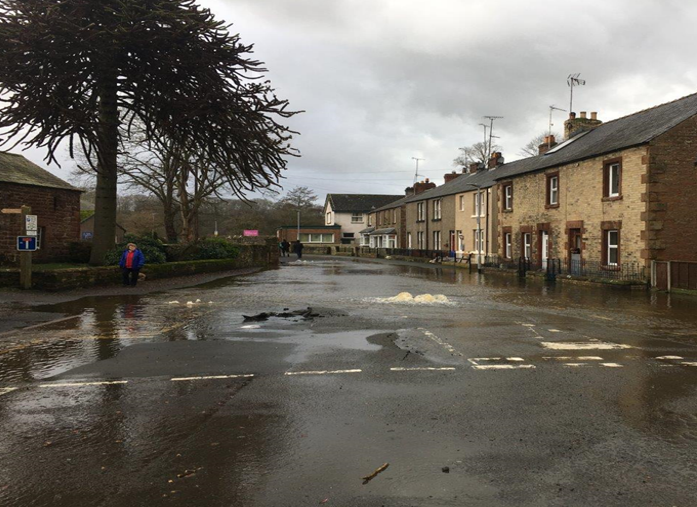
Following the 2015 flooding the Environment Agency (EA) has been trying to develop a scheme to reduce flood risk in the town.
When flows in the Eden are high, water cannot leave Doomgate culvert causing a backup within the pipe network resulting in surcharge of water through the manholes in Holme St. When levels on the Eden are high for long periods of time, water starts to flood lower lying properties in Holme St. and Chapel St.
This mechanism is the most frequent source of flooding for this area of the town.
The Environment Agency are required to follow Flood and Coastal Erosion Risk Management Appraisal Guidance (FCERM AG). This process identifies the most economically viable option, and this represents the best option for spending taxpayers money. The appraisal process identified that the pumping station is the only option that was viable within this guidance. The FCERM AG is available online for review FCERM appraisal guidance – GOV.UK (www.gov.uk)
The scheme reduces risk from surcharging of the Doomgate culvert. This option provides a 1.33% (1 in 75) standard of protection to the Town Centre and reduces flood risk to 64 properties. The benefits of the scheme have been quantified and a detailed cost/benefit analysis has been completed as part of our work in developing the scheme. Over the period of the asset’s lifespan, it is anticipated that the benefits total approximately £21,000,000. The quantifiable damages are obtained by assessing the costs associated with direct damages (and subsequent repair costs) to:
In addition to this, there are indirect damages such as:
This is not an exhaustive list and other factors are considered when calculating the benefits that the scheme provides.
As a result of the scheme, the Environment Agency expect to see much less frequent surcharging of the Doomgate culvert and therefore flooding from manholes. This flood water has the potential to flood peoples’ homes and businesses which leads to high repair costs and potentially long-lasting damage to mental health. This flooding affects properties around Holme Street, Chapel Street, Doomgate, High Weind, Low Weind and Bridge Street as well as local infrastructure. Additionally, with the pumping station in place and operating – these roads would still be useable by residents who require access to their homes & businesses. They might not otherwise be able to do this without the pumping station as the roads could be flooded and unsafe to drive through.
This scheme doesn’t reduce risk from other sources (i.e. River Eden) but does mean that the town centre is protected to the same level from both mechanisms, bringing the town to the same standard of protection (parity). The scheme promotes a proactive response to managing flood risk as opposed to a reactive approach which is what the town currently relies on.
For the safety of the public, the Environment Agency is pausing the construction of the Appleby Flood Scheme ahead of the 2025 Horse Fair, and the temporary Edenside Car Park will be closed from Monday, June 2 and reopen Tuesday, June 10.
Concrete barriers will be placed at the entrances to our working areas to prevent public access and ensure public safety. The EA are working closely with Appleby Town council (ATC) and Westmorland & Furness council (W&F) to ensure that all necessary measures are in place ahead of the fair.
On-site security personnel will regularly monitor the closed sites to ensure the compound and construction areas are secure while the project team continue to work off-site.
The safety of the public is paramount, and with so many visitors coming to the town and the scale of the works taking place, it is essential the the work on the Appleby Flood Scheme is pause for the duration.
The Appleby teams will be working off-site, and this pause in construction is part of the planned work schedule and will not impact the progress of the scheme.
Appleby school children providing arts work with Environment Agency and contractors
Children are getting the opportunity to celebrate the biodiversity of their local river, creating artwork to be displayed alongside the River Eden where the Environment Agency and their contractors VolkerStevin and constructing a flood risk management scheme.
With donations of art materials to Appleby School by Volker Stevin the Appleby Primary School pupils are creating their own interpretation on wildlife they have seen along the River Eden in their town.
The majority of the children say they have seen the animals they are painting, which are rarer in other part of the England including red squirrels, otters and crayfish. The young artists from Year Six are also decorating wooden designs of trout, swans, beetles and rabbits. A selection of the pieces will be displayed around the play area next to the river in the town.
Deputy Head and Year Six Teacher, Terry Caygill said: “It is a wonderful opportunity for the children to be able to celebrate the wildlife we see in our town, and have it displayed for everyone to see.
“It is amazing how many of these animals the children have seen, and many regularly when in the town.”
Environment Agency Project Manager for Appleby Flood Risk Management Scheme, Ross McKeown said: “Our team have been fortunate to see a number of the animals the children are creating for the art display in and around the river where we are working. We look forward to opening the outdoor art exhibition of their work in the spring for locals and visitors to enjoy.
“This is a great opportunity to celebrate the biodiversity of the River Eden whilst we construct the scheme which will better protect 64 properties and infrastructure from flooding from the river, including road access to homes and businesses.”
VolkerStevin Customer Experience Coordinator is working with the school, providing the art materials and arranging the display at the playarea.
More information about the Appleby Flood Risk Management Team is available from the Appleby Flood Hub thefloodhub.co.uk/Appleby/

VolkerStevin Customer Experience Coordinator, Matthew Davenport with pupils from Appleby Primary School, using the arts materials provided by Appleby Flood Risk Management Scheme team.

Appleby Primary School’s Deputy Head and Year Six Teacher, Terry Caygill with pupils painting the wildlife images which will be on display later this year along the riverside in Appleby.
Alternative weekend working will start this Saturday (11th January 2025) in order to maximise efficiency and minimise disruption to the public for the next phase of the Appleby Flood Scheme.
Environment Agency contractors will be working from 7.30am until 5pm on both Saturdays and Sundays on alternative weekends, however no machinery will be used before 8am. This revised working arrangement will continue until the shaft and tunnelling works are complete.
When tunnelling, it is crucial to minimise the time the tunnel boring machine (TBM) remains stationary. Prolonged inactivity increases the risk of the ground closing around the machine, potentially rendering it stuck. The only option then would be to dig down to retrieve the TBM, which is a complex and time-consuming process.
Whilst Broad Close car park is closed to the public, the Environment Agency plan to maximise the working hours and minimise the time where the car park is closed.
The Environment Agency are grateful for your understanding and patience. They are committed to completing the scheme while avoiding peak holiday and tourism periods as much as possible.
A new outfall into the River Eden has been completed and work is now progressing on the construction of the new pumping station in Broad Close car park for the Appleby Flood Scheme.
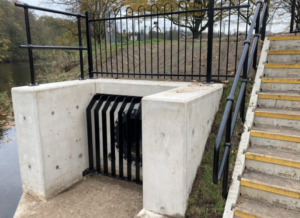
Piling works for the control building foundations are now complete.
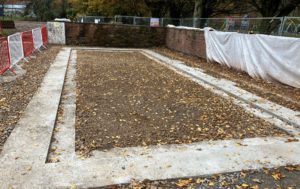
The next phase of construction work involves the installation of five large shafts for the pump wet well, valve chamber, and new culverts. These works will require a full closure of Broad Close car park from Monday 25 November.
Appleby Castle car park will remain open to the public on a pay-and-display basis until the opening of the new temporary car park at Edenside. The Castle car park will be open between the hours of 09:00-17:00 Tuesday to Saturday.
Demolition work on the former Edenside Care Home is now complete. The Environment Agency are due to take over the land in mid-November, and will create a new, free temporary car park on the site. This work will take approximately five weeks, and the temporary car park is due to open in December.
The construction work on the scheme is due to be completed in 2026.
If you have any questions that aren’t answered with the information on The Flood Hub, please email them to the Environment Agency team at [email protected].
Work starting on new Pumping Station for Appleby Flood Scheme
The Environment Agency and their contractor VolkerStevin have commenced work on the Doomgate Beck Pumping Station as part of the Appleby Flood Risk Management Scheme. Works are continuing on the new outfall structure and installation of the site compound.
Works within Broad Close car park are due to start on 16 September. When completed, the scheme will better protect 64 properties and infrastructure from flooding, including road access to homes and businesses.
While construction work is ongoing within Broad Close car park, the area will be partially closed for public safety. However, 10 spaces will still be available until the opening of the temporary car park at the former Edenside Care Home.
The Environment Agency is delighted to be working with the Oaklea Trust, a local charity, to utilise the Edenside site as a free temporary car park following demolition of the existing building. Work on the demolition has now started and following completion of the demolition, work to create the free temporary car park on this site will take place. The free temporary car park is due to be open from early December.
To ensure the project remains on schedule and to avoid construction taking place over two further summer holiday periods, work will start ahead of the free temporary car park being open. The closure of Broad Close car park has been carefully considered to accommodate the end of the school holiday period and to avoid disruption as much as possible.
The Environment Agency is grateful for your continued understanding and patience. To minimise disruption, they are working to complete the scheme within the 20-month schedule, avoiding as many peak holiday and tourism periods as possible.
If you have any questions that aren’t answered with the information on the Flood Hub, please email them to the Environment Agency team at [email protected].
Following recent preparation work to divert services, the Environment Agency and principal contractors VolkerStevin will be starting on Monday 1st July to set up the compound area next to the leisure centre and swimming pool.
Construction will also begin on the first phase of the Appleby Flood Scheme. This work will not involve any work in the Broad Close car park, which will remain open to the public.
The compound will provide site welfare facilities for the team working on the project and will be used to store building materials.
The public footpath which runs through this area will be closed for the duration of the project, which is due to take around 20 months. The footpath between Holme Street and the play area will also be closed. However, the river side footpath past the leisure centre and swimming pool will remain open. Diversion signs will be in place and the toilets and recycling facilities at Broad Close car park will remain open.
The first phase of the works will focus on constructing a new outfall. This is a concrete structure on the bank of the River Eden that will be connected to the new pumping station in Broad Close car park.
The Environment Agency will need to complete the outfall construction works, within the summer months whilst the river levels are low. This work is due to take around 16 weeks to complete.
As work start work on the first phase of the project, there will be a small working area set up to the west of Broad Close car park. There will be increase in traffic in this area. The Environment Agency apologies for any inconvenience.
Environment Agency principal contractor VolkerStevin will be undertaking these works and will keep you updated through the next phases of the project.
How may this affect you?
You can the Environment Agency regarding these works please call their helpline on 03708 506 506 quoting the job reference ‘Appleby FRMS’ or email [email protected].
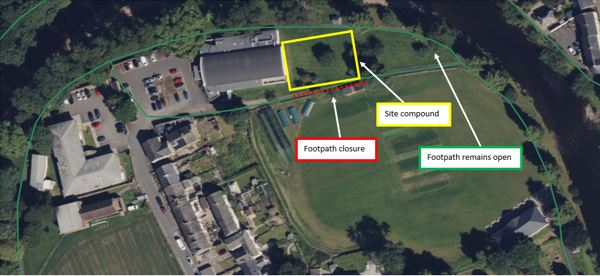
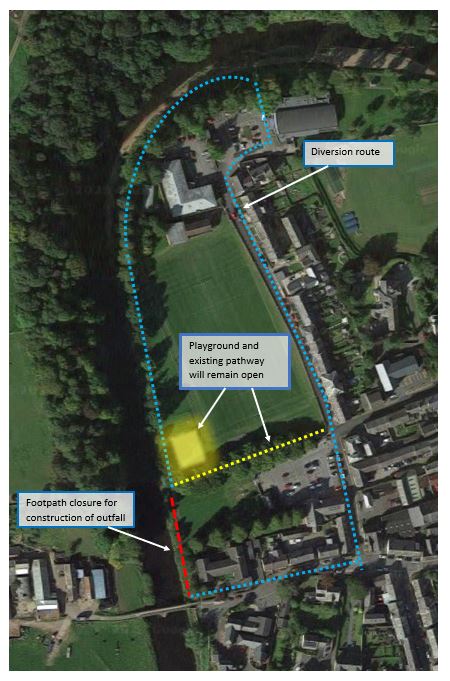
The construction programme for Appleby Town Centre Flood Risk Management Scheme Doomgate Culvert will be 20 months in duration. Work started Summer 2024 with the programme due to be completed Winter 2025/6. It should be noted that the final 3 months of this programme will be testing and commission with minimal site staff and removal of the main site establishment areas.
The works will be undertaken in 4 discrete areas which are shown on the following image. Area 5 (not shown on the following image) is the site office compound which is located adjacent to Appleby Leisure Centre.
The following sections describe the works to be carried out and the traffic management requirements for each area. There is further information within the FAQ’s section relating to the construction programme and any impact.
Utility Diversions
The Environment Agency are working with Electricity Northwest Ltd, Northern Gas Network, and United Utilities (UU) as their services need to be redirected before works commence.
Holme Street Phases 1 & 2
The first phase of utility diversions was completed in September 2023, with the second phase due to commence in Holme Street on 19th February 2024. This includes United Utilities connections for approximately 1 week, followed by Northern Gas for approximately 3-4 weeks. The Environment Agency with endeavour to maintain access to all businesses.
Whilst a full road closure is not required, there will be some temporary traffic management in place in the form of 4-way traffic control signals to undertake the works. An indicative layout is detailed below:
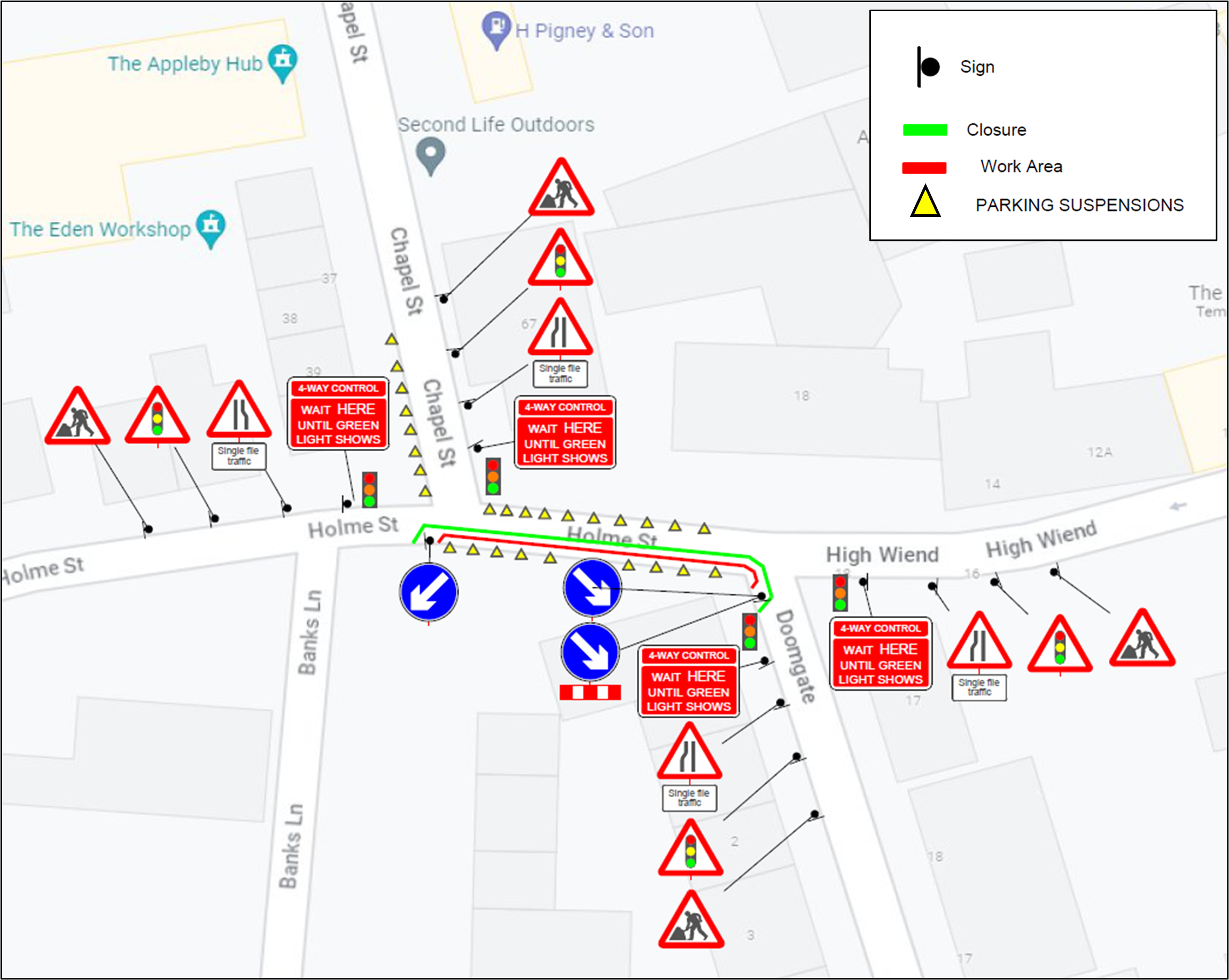
Chapel Street
The utility diversions in Chapel Street are due to commence towards the end of March following the completion of the second phase of the Holme Street works and will take approximately 3-4 weeks. The works comprise of the diversions of a combined sewer and a water main to allow space to install the new chambers for the flood risk management scheme. Due to the location of these assets, an area of Chapel Street will need to be closed to vehicles. The Environment Agency will endeavour to maintain access to all businesses.
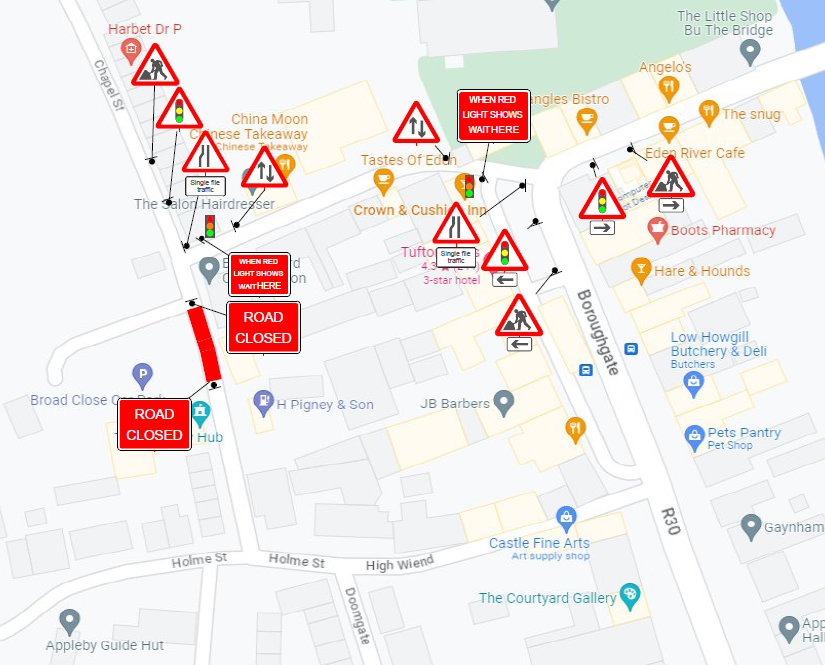
Work Areas
To safeguard both members of the public and the Environment Agency’s operatives, it is necessary to have TM plans in place. To maintain traffic flow around Appleby, the Environment Agency will implement specific plans for different construction activities. These plans ensure all works are carried out safely and securely for both the public and the Environment Agency’s staff whilst minimising inconvenience.
The following durations are indicative, and exact dates will be confirmed following contract award and confirmation of the construction start date. A number of factors can accelerate or delay construction progress. If there is any change in the programme delivery, the Environment Agency will communicate this as soon as identified.
Further phases will be released in due course once dates are confirmed.
From 02/04/25, Chapel Street will be fully closed to facilitate the construction of the drive shaft. To ensure access is maintained past the working area, Low Wiend will be converted into a two-way street, with a traffic light system implemented to manage traffic flow effectively. Access to The Appleby Hub and H Pigney & Son will remain available, and pedestrian access past the working area will be maintained.
From 17/04/25, Chapel Street will revert to a partial one-lane closure, with parking suspensions. Traffic flow will resume as normal along Chapel Street. Some parking bays will be retained were possible.
Low Wiend will return to its usual arrangement. Holme Street will be reduced to one lane to allow for the micro tunnelling connection from Chapel Street to Holme Street. A two-way light system will manage traffic on Holme Street, and this arrangement will remain in place until the work is completed, at times 2-way lights may not be needed. This is expected to be in place for approximately 10 weeks.
Pedestrian access to properties and businesses will remain.
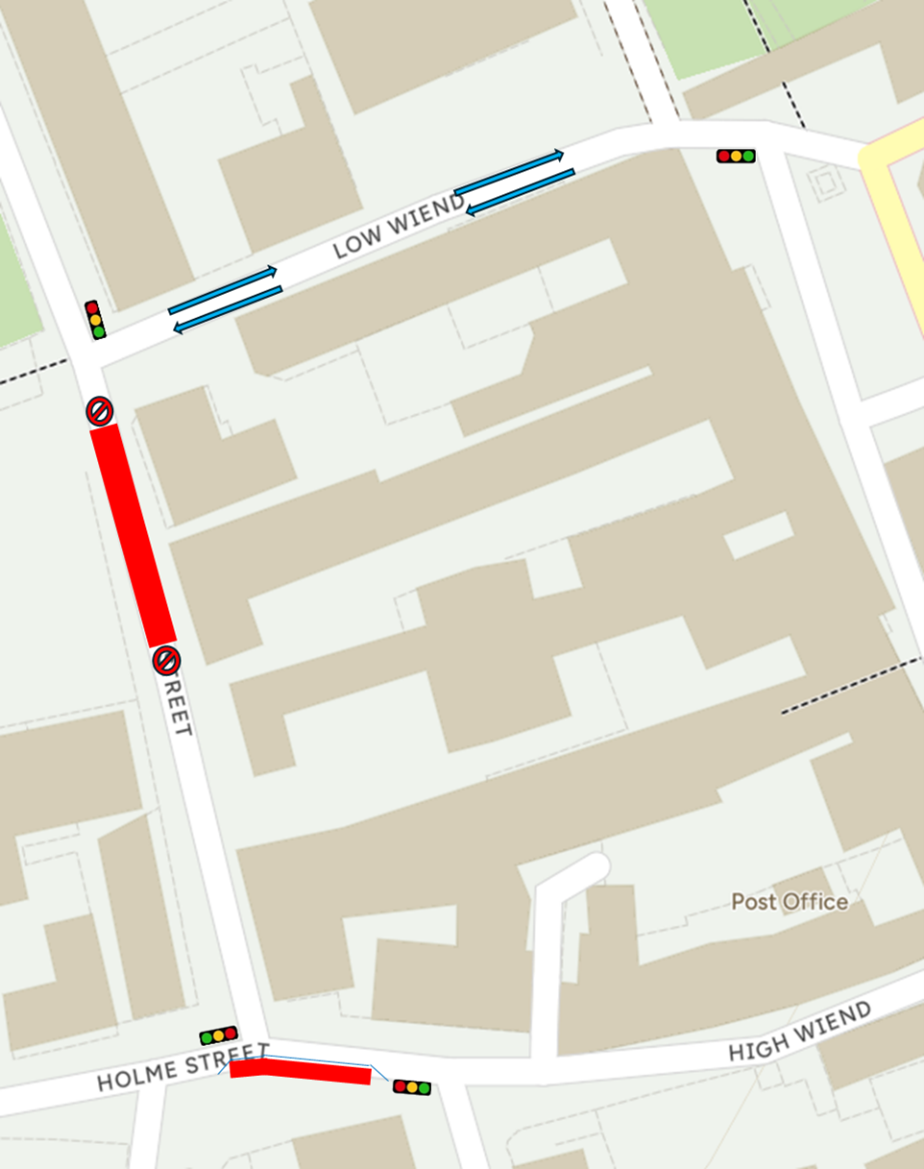
From 16/06/25, Chapel St will be fully closed in this area (mirroring the arrangement outlined in Phase 1), while Holme Street will remain as a partial closure following completion of the tunnelling works.
This is required in order to allow for the drive shaft chamber (in Chapel St) to be reduced in size and the underground services within this area to be put back to its original alignment.
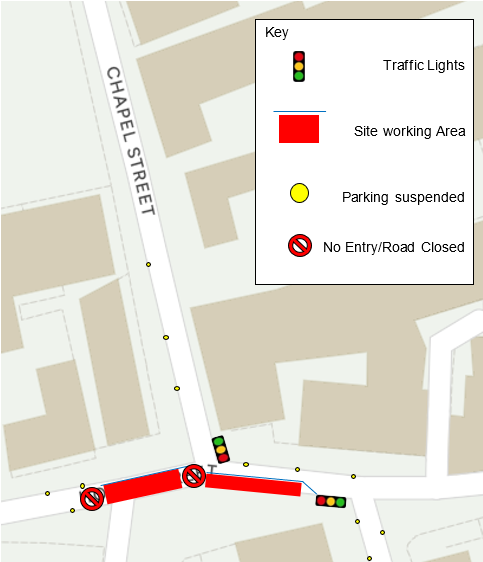
From w/c 21/07/25, the phase 3 traffic management on Chapel Street will be removed as the tunnelling works in this area will have been completed.
The next phase of work requires a road closure on Holme Street with traffic lights to control traffic around our working area.
To facilitate these works, a full road closure will be in effect for approximately five days starting from 28/07/25. Following this, a single-lane closure will be required for a further eight weeks. Please note that these timeframes are subject to change depending on weather and site conditions. Appropriate signage and safety measures will be in place throughout the duration of the works, and parking suspensions will also be enforced.
As a result of the road closure, the Edenside Car Park will also be closed due to the lack of vehicle access. The car park will be reopened once the initial connection works are completed, and access can be safely restored.
There will be parking available at Appleby Castle, between the hours of 09:00 – 17:00 during the full road closure. There will be a small fee of £5 for an all-day parking pass to access the car park.
During the works, access for pedestrian and dismounted cyclists will be maintained around the working area. However, vehicle access will not be permitted, with the exception of emergency vehicles.
The purpose of the closure is to allow for a connection to the existing Doomgate culvert, which is located in the centre of Holme Street, opposite Banks Lane. This connection will link with the newly installed pipework beneath Chapel Street.
Following the single lane closure on Holme Street, the Environment Agency are not anticipating any further traffic management to be required for the remainder of the scheme.
Micro-tunnelling is a process that uses a remotely controlled micro-tunnel boring machine combined with the pipe jacking technique to install pipelines underground. It is currently the most accurate pipeline installation method; it avoids the need to have long stretches of an open trench for pipe laying which can cause extreme disruption to the community.
Micro-tunnelling the new culvert will reduce disruption for the community, it has a faster rate of installation compared to an open cut trench solution. The disruption to traffic is also minimised as the works are completed underground meaning the working area above is reduced.
Micro-tunnelling is the preferred method due to this process having minimal noise and vibration. As a result of the micro-tunnelling, there is no risk to the adjacent properties in terms of settlement. This is a well established construction method for use in town centres where space is limited.
A new 3.6m diameter overflow chamber will be constructed offline of the Doomgate culvert.
CFA stands for Continuous flight auguring, and is a technique used in construction to create concrete foundations. Being almost vibration free, it is one of the quietest forms of piling which makes it ideal for environmentally sensitive areas. It is suited to a range of different ground conditions and installation is quick compared to other pile types. They are suitable for a wide range of challenging ground conditions, such as the alluvial ground (historic river deposits) at Appleby.
The piles are constructed by rotating a hollow stem auger into the soil to a specified depth. Concrete is pumped through the stem, to fill the cavity created as the auger is slowly removed. The reinforcement cage is placed in the concrete.
Broad Close car park will be unavailable for the majority of the Environment Agency’s works (17 months) although the public toilets will remain open, and access will be maintained for the duration of the works, if it safe to do so. The Environment Agency will explore the potential to complete a staged handover of car parking spaces as the programme and health and safety allows.
The River Eden is designated a Special Area of Conservation (SAC) and Site of Special Scientific Interest (SSSI). Due to its designations, the Environment Agency are restricted to an ‘in-river’ working window which begins in June and finishes at the end of September. The new outfall will be constructed during this period in 2024.
To find out more about the River Eden’s SAC and SSI designations follow this link: European Site Conservation Objectives for River Eden SAC – UK0012643 (naturalengland.org.uk)
In order for us to construct the new outfall, a short section of the footpath on this section of the river will be closed for the duration of the works, which the Environment Agency anticipate will take approximately 3 months to complete.
This plan shows how the Environment Agency will implement a temporary footpath diversion to enable construction of the new outlet structure into the River Eden.
Approximate dates for this work are in line with the in-river working window. This is currently planned for June-September 2025.
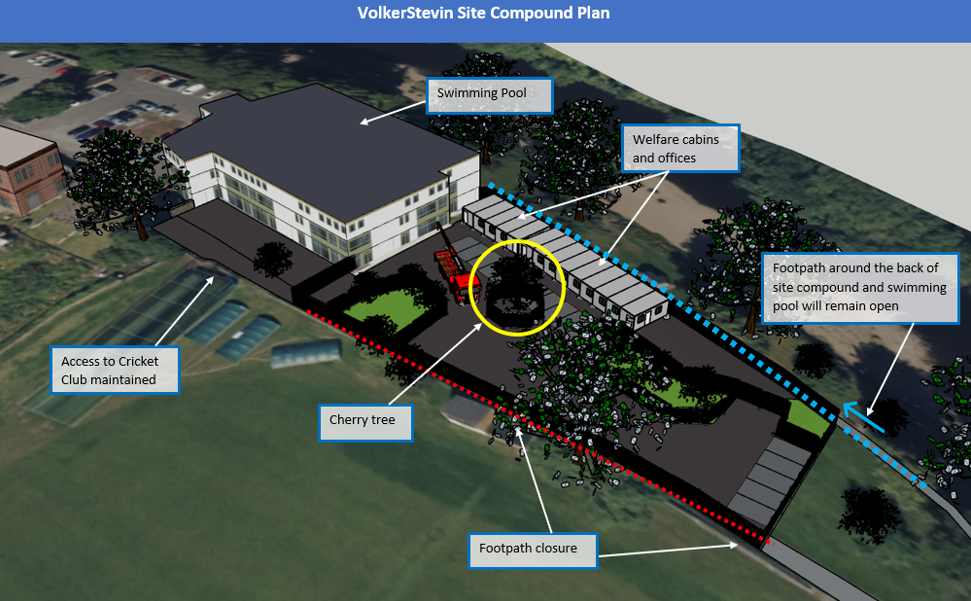
VolkerStevin Site Compound Plan
The plan shows the VolkerStevin site compounds proposed location next to the swimming pool. Welfare cabins and offices will be installed, and the area will accommodate staff parking with approximately 15 spaces provided.
The Environment Agency will endeavour to retain the Cherry Tree within the site compound area. If all measures are employed and the Environment Agency are unable to retain the tree, it will be removed. In line with the Environment Agency’s planning application, 5 other trees will be planted each with a 5-year aftercare programme to ensure their survival.
All other trees located within the site compound area are subject to tree protection measures and will be retained.
A short footpath closure will be in place for the duration of the scheme which can be seen on the map below. The riverside footpath around the back of the swimming pool and site compound will remain open. Access to the cricket club will be maintained and the swimming pool will have arranged maintenance access through the site compound.
The Environment Agency also have a detailed landscape masterplan that outlines the enhancements the Environment Agency will be providing as part of the scheme. This includes:
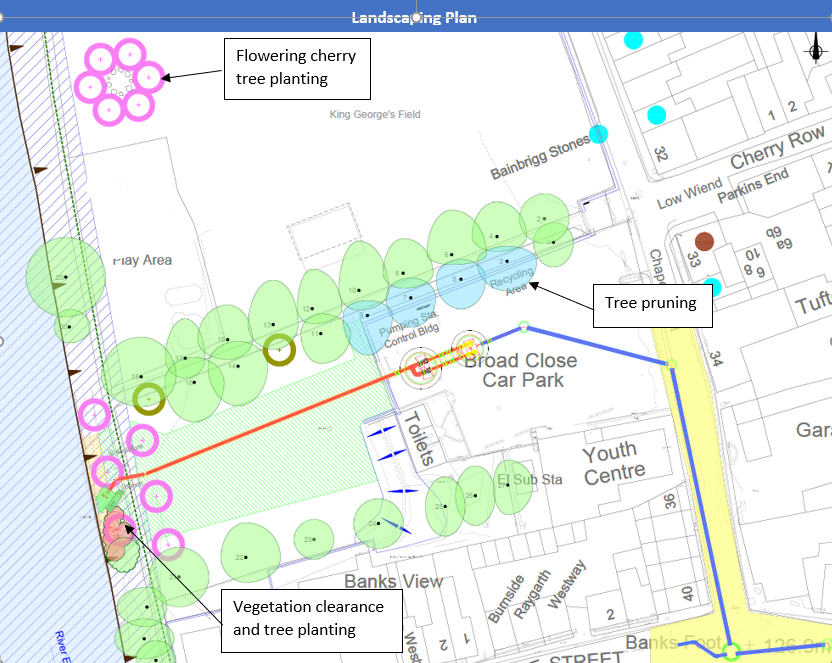
Landscaping Plan
Prior to works commencing, the Environment Agency have instructed Brown Rural (Chartered Surveyors) to undertake some pre-entry condition surveys of various properties and buildings in the vicinity of the construction working area. This includes, but is not limited to, properties near to the works, or on the construction traffic routes around the town. This will enable the Environment Agency to record the pre-existing condition of the property both externally and internally, so in the unlikely event that any damage was caused by the works and associated vehicles, this could be clearly identified. This will be for the benefit of both parties, and in the very unlikely event that this did occur, you would need to contact either The Environment Agency or Brown Rural so that a further inspection could be arranged.
Brown Rural have begun issuing letters to properties which fall within the required survey area. Your assistance with this element of the scheme will be greatly appreciated. If you have any queries or concerns, please feel free to contact Brown Rural directly. The Environment Agency project inbox is also open for any further queries: [email protected].
The Environment Agency estimates 185,000 businesses in England and Wales are in an area at flood risk.
By planning and preparing you can work towards making your business more resilient. A flood resilient business may experience less of an impact if a flood occurs, allowing for business continuity.
From creating a flood plan, to protecting your products, there are many resources available to help you plan and prepare for flooding to your business.
You can find out whether your business is at flood risk by visiting www.gov.uk. This free service will provide information on:
Ensuring your business has an effective flood plan in place will enable you to respond to flooding more efficiently. You can do this by:
An additional consideration to make your business more resilient is to understand any flood risk impacts to your business supply chain.
By implementing steps to minimise risks will protect your ability to continue to operate.
It is important that your business is fully insured and covers high value items such as equipment and machinery.
It is important that your business is fully insured and covers high value items such as equipment and machinery. There are a number of options available for commercial flood insurance and include;
The Environment Agency are constructing a risk management scheme to better protect properties from future flooding. The scheme being delivered along the river corridor in Appleby will include the construction of a new pumping station, span over 20 months and will directly impact a number of town centre businesses. This guide provides information on business support available to any business directly impacted by our construction works to ensure business continuity and resilience during this time.
Businesses can suffer financial losses as a direct result of our works in a number of ways:
If your business has suffered a demonstratable financial loss due to one or more of these, please contact us via email at [email protected].
Compensation for substantiated financial losses as well as other help is available for businesses directly affected by our flood works. If your business has suffered as a direct result of our construction activity, the Environment Agency would like you to get in touch. You can contact us via email at [email protected].
The Environment Agency will determine every claim based on evidence of any financial losses as a direct consequence of the Environment Agency’s construction works. Each claim raised with the Environment Agency will be discussed and addressed by a specialist team on a case-by-case basis with a bespoke support service provided. All information shared with the Environment Agency in making any claim will be dealt with in a confidential manner.
If you would like to talk to a member of the Environment Agency team, or keep up to date on progress, there are many ways you can do this. Information on how you can get in touch, or where to find information is provided below.
The Environment Agency appreciate that the construction works being delivered through Appleby will have an impact on the local community and they thank you for your continued patience.
It is important that you are prepared and know what to do if flooding threatens. The Environment Agency encourage you to take 4 simple steps:
Further information is available on our website www.gov.uk/flood or by ringing Floodline on 0345 988 1188.
1. What will happen to the recycling facilities? Will the toilet facilities in Broad Close car park be available during the construction phase?
Access to the toilet facilities in Broad Close car park will be maintained on a best endeavours basis. There may be occasions when the toilets are temporarily out of access as a result of specific construction activities, but the Environment Agency will minimise this as much as possible.
Recycling facilities will be temporarily moved out of Broad Close car park. They will be relocated on Westmorland and Furness Council (W&F council) land adjacent to the Heritage Centre near the train station. The long-term destination of the recycling centre is something that the Environment Agency will seek to confirm with W&F Council. It could be that maximising available parking spaces following construction is seen as more important than having the recycling facilities in Broad Close car park.
2. What impact will the construction work have on car parking? Will there be fewer parking spaces on completion?
Broad Close car park will be entirely closed for much of the construction programme. Car parking spaces will be temporarily unavailable due to the occupation of Broad Close Car Park for approximately 17 months during the construction period. However, the Environment Agency will look to complete a staged handover of car parking spaces as the programme & health and safety allows. The Environment Agency’s current assumption is that there will be a reduction from 61 to 45 standard bays with the existing 3 disability bays and 3 motorcycle bays to remain. This is based on W&F Council making the decision to return the recycling centre to Broad Close car park following completion of the project as described in FAQ 1. If W&F Council decide to permanently relocate the recycling centre, there will be a reduction from 61 to 52 standard bays with the existing 3 disability bays and 3 motorcycle bays to remain.
Parking along the section of Chapel Street from Broad Close car park entrance to Chapel Street will be impacted at times during the construction programme. Similarly, there will be periods when parking on parts of Holme Street will be impacted. Please refer to the traffic management section for further information.
3. Will additional car parking be provided during construction?
The Environment Agency have worked with partners to secure additional parking provision in Appleby to mitigate any potential disruption caused by the temporary closure of Broad Close Car Park.
Appleby Castle
Around 20 pay and display spaces are available at Appleby Castle Tuesday-Saturday, between the hours of 09:00-17:00.
Bowling Club
A limited number of spaces have been allocated at the Bowling Club. Permits are managed by Appleby Town Council.
Holme Street (former Edenside Care Home)
In partnership with the Oaklea Trust, we are constructing a free, temporary car park on the site of the former Edenside Care Home. This car park is expected to open in December.
These arrangements are subject to change. For the latest information, ‘visit the What’s Happening section’.
4. What impact will the construction work have on footpaths and access to King George V playing field and around the swimming baths?
A short section of the existing public footpath along the edge of the river between Holme St. and King George V playing field will be temporarily closed and a diversion route established (refer to the traffic management section on The Flood Hub page for further information). The path on King George V playing field and the playground will remain open.
The footpath between the swimming pool and the cricket pitch will be temporarily closed and a diversion set up to take people along the existing river side path.
5. Have you considered all possible options to reduce flood risk?
Following the 2015 flooding the Environment Agency has been developing a project to reduce flood risk in the town. The EA are required to follow Flood and Coastal Erosion Risk Management Appraisal Guidance (FCERM AG). This process identifies the most economically viable option, and this represents the best option for spending taxpayers’ money. The appraisal process identified that the pumping station is the only option that was viable within this guidance. The FCERM AG is available online for review FCERM appraisal guidance – GOV.UK (www.gov.uk).
Through the appraisal process, a long list of potential options is developed which is then refined to a short-list from which a preferred option is identified. The long list included options such as upstream storage and raising existing flood defences within the town.
The preferred option (identified during the appraisal process) involves the installation of a pumping station and associated pipework and outfall for Doomgate Culvert. Other options identified were not viable due to economic and technical constraints.
This mechanism is the most frequent source of flooding for this area of the town. This scheme ensures that the town centre is protected to the same level from both flooding mechanisms, bringing the town centre to the same standard of protection (parity). The scheme promotes a proactive response to managing flood risk as opposed to a reactive operational response, which is what the town currently relies on.
6. Have you considered other locations for the pumping station? Why Broad Close car park?
Broad Close car park is the most suitable place the Environment Agency can fit the pumping station (there is not enough room at the end of Holme Street and the Environment Agency can’t construct at the site of the existing pumping station as it pumps a United Utilities combined sewer overflow).
7. What is the impact on businesses during construction?
The information contained within this Flood Hub page provides detail that have answered specific queries from residents and businesses. The Environment Agency acknowledge that there are more generalised concerns around the overall impact to businesses as a result of the project. The Environment Agency have assessed that impact to businesses will be minimal due to the following:
8. Did the scheme go through the planning process?
Two applications were approved by Eden District Council in relation to this scheme.
Application 21/0869 is for the main scheme and was approved in January 2021. It includes all the associated plans, statements, and drawings etc.
The recently determined application 22/0713 is for a secondary compound on land adjacent to the swimming pool in Appleby, as such it doesn’t have information related to the main scheme application.
These applications were considered by Eden District Council based on the planning related aspects. There are other aspects of the scheme such as the structures in the road and diversion works etc. that don’t need to go through the development planning process and as such are not included in the planning applications.
The planning authority considers the development planning aspects on their merit in context of national and local planning policy. The details the Environment Agency supplied in support of the planning applications were the details as the Environment Agency understood them at the time. As the project has developed the understanding of how the Environment Agency will deliver aspects of the scheme has changed.
9. Why has the duration of the construction programme increased?
The shortest programme the Environment Agency have assessed was 9 months at the early planning stages. The previous 9-month estimate was based on the Environment Agency’s initial construction programme which was proportionately detailed to the stage of the project. The previous programme identified a series of tasks that could be undertaken in parallel. Since that time, the Environment Agency have further developed the design and have a better understanding of the construction methodologies. It is now clear that given space constraints, construction activities need to be undertaken in sequence. This has resulted in an increase in the duration of the construction programme.
10. Will any trees be cut down as part of this scheme? And what are the proposed enhancements/mitigations?
A cherry tree in the centre of the secondary compound may need to be removed but the Environment Agency will endeavour to retain this subject to the practicalities and health and safety implications.
Where there is a need to remove trees, the Environment Agency will be replacing them on a 5 to 1 basis, with a 5-year aftercare programme to ensure that they survive. Please refer to the Landscaping and enhancements section on the Flood Hub page for further information.
11. Will the Fire Service be able to operate during the construction of the scheme?
Access to the fire station will be temporarily impacted (3 weeks) by the road closure on Holme Street. The Environment Agency will work with the Fire Service so that they can develop a suitable plan to provide the service required to the town and wider community during this period.
12. What additional Environment Agency work is taking place prior to main scheme?
The Environment Agency have completed two smaller projects in the vicinity of the Leisure Centre. These works were complete in Summer 2023.
In order to facilitate construction of the main scheme, services (utilities like water, gas, power) will need to be diverted in Chapel Street and Holme St. These works need to happen ahead of the main scheme. The Environment Agency are working with the service providers to complete this. Please refer to the Utility Divisions section for further information.
13. What will your working hours be?
Working hours will be from 07:30 – 18:00, with the first half an hour being used for morning briefings. Site works and construction activities will therefore be restricted to 08:00 – 18:00 Monday to Friday. Works on Saturdays, Sundays and Bank Holidays will be avoided, except in emergencies or as otherwise agreed in advance with Westmorland and Furness Council.
14. Is there a process to compensate businesses impacted by the scheme?
Yes, this is available upon request. Please email [email protected] to request this information.
15. How are you going to share information about the scheme?
The Flood Hub page will continue to be updated with any relevant information throughout the duration of the scheme.
Any specific queries can be sent to [email protected].
16. How will roads be affected by the scheme?
Different roads are under traffic management for different periods of time at different times in the wider programme, this isn’t a continuous closure. Controlled access will be maintained for all residents and businesses. The Environment Agency will never remove access entirely for residents in the town. Whilst the Environment Agency’s programme is 20 months long, they do not anticipate large volumes of construction traffic. The programme is linear and does not involve large quantities of materials that need to be brought into the town. Most of the Environment Agency’s programme involves specialist equipment which needs to be brought to site once and taken away once.
Please refer to the traffic management section on The Flood Hub page for further information regarding the specific impact on the road network.
17. Is the scheme economically viable?
Construction projects are often complicated and expensive. The Doomgate pumping station project has been subject to the cost inflation pressures that many construction projects have experienced recently. As cost increases it can reduce the cost benefit ratio such that a project ceases to be cost beneficial and Treasury rules mean that the project cannot progress, the costs outweigh the benefits. At present the Doomgate pumping station project is viable (meaning the benefits outweigh the costs) but prior to entering into a construction contract, another cost estimate is required. The result of the cost estimate will be key to viability of the project and whether or not the project can progress through to construction.
18. Why is the secondary compound being located where it is?
As the Environment Agency finalised the detailed design, it became apparent that more space than was available in Broad Close car park would be required. Additional space was required in order to undertake the construction work and accommodate staff parking and cabins, so it started to look at alternative locations. Inquiries were made with the land owner (W&F Council) to use the land adjacent to the Broad Close car park on King George V playing field, due to its close proximity to the work. The Environment Agency were informed that this option was not acceptable and W&F Council identified an alternative site on land they owned adjacent to the swimming pool. This site was able to accommodate what was required and was taken through the planning process.